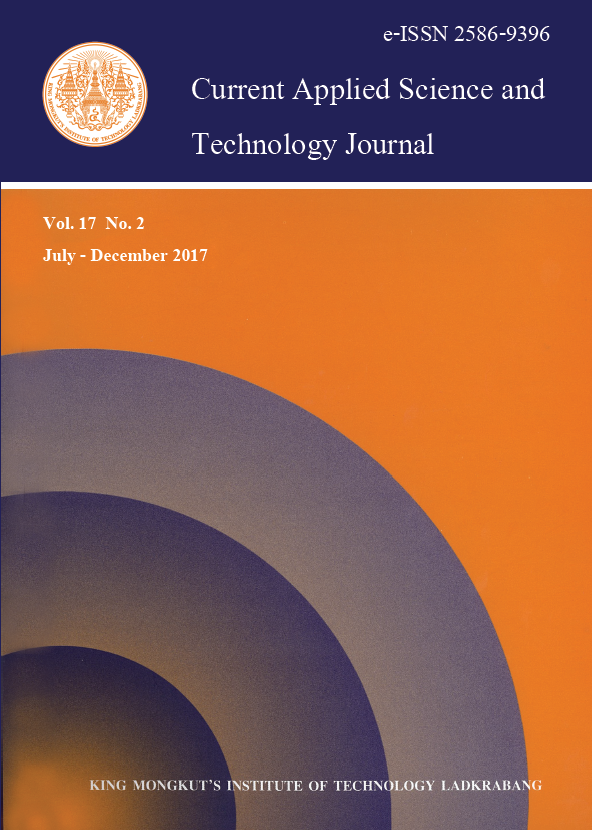Quality Changes and Volatile Compounds in Fresh-Cut ‘Phulae’ Pineapple during Cold Storage
Main Article Content
Abstract
The effect of cold storage temperature on quality changes and volatile compounds in fresh-cut ‘Phulae’ pineapple was determined. Samples were cut and dipped in 2% NaCl solution for 1 min, packed inpolypropylene bag and stored at 5, 10 and 15°C + 1°C. Physico-chemical characteristics, microbiological quality and volatile compounds using headspace gas chromatography-mass spectrometry (GCMS-HS) were evaluated every 2 days until 2 weeks of storage. The lighter flesh color, the bright visual good appearance retained at all storage temperatures. Ascorbic acid content was in the excellent source for all temperatures (30 - 19 mg/100g fresh weight). More than 30 volatile compounds were identified. The predominant compounds were ethyl acetate, acetic acid, ethyl butanoic acid, hexanoic acid, octanoic acid, dodecanal, nonanol, butanol, butanoic acid ethyl ester (methyl ester), butanoic acid 2-methyl-, ethyl ester (methyl ester) and so on. The increasing of storage temperature also increased two times of the ethyl acetate and acetic acid productions. A relationship between microorganisms and carbon dioxide productions were observed. The ethyl acetate and acetic acid amounts in fresh-cut sample were found in increasing numbers as increased yeast and mold counts at all storage temperatures. Total plate count was in safety range (2-5 log CFU/g) along 14 days at 5+1°C according to the Regulation of Department of Medical Sciences. The results obtained from this experiment could be used for the development of spoilage indicator that can be applied for fresh-cut ‘Phulae’ pineapple in order to maintain the quality and safety products for consumers.
Keywords: carbon dioxide, GCMS-HS, ‘Phulae’ pineapple, quality changes, volatile compounds
*Corresponding author: Tel.: +66-5391-6751 Fax: +66-5391-6737
E-mail: phunsiri.s@mfu.ac.th
Article Details
Copyright Transfer Statement
The copyright of this article is transferred to Current Applied Science and Technology journal with effect if and when the article is accepted for publication. The copyright transfer covers the exclusive right to reproduce and distribute the article, including reprints, translations, photographic reproductions, electronic form (offline, online) or any other reproductions of similar nature.
The author warrants that this contribution is original and that he/she has full power to make this grant. The author signs for and accepts responsibility for releasing this material on behalf of any and all co-authors.
Here is the link for download: Copyright transfer form.pdf
References
[2] Goff, S.A. and Klee, H.J., 2006. Plant volatile compounds: sensory cues for health and nutritional value? Science, 311(5762), 815-819.
[3] Berger, R., Neuhäuser, K. and Drawert, F., 1986. Characterization of the odour principles of some basidiomycetes: Bjerkandera adusta, Poria aurea, Tyromyces sambuceus. Flavour and Fragrance Journal, 1(4‐5), 181-185.
[4] Tokitomo, Y., Steinhaus, M., Büttner, A. and Schieberle, P., 2005. Odor - active constituents in fresh pineapple (Ananas comosus [L.] Merr.) by quantitative and sensory evaluation. Bioscience Biotechnology Biochemistry, 69, 1323-1330.
[5] Umano, K., Hagi, Y., Nakahara, K., Shoji, A. and Shibamoto, T., 1992. Volatile constituents of green and ripened pineapple (Ananas comosus (L.) Merr.). Journal of Agricultural and Food Chemistry, 40, 599 - 603.
[6] Montero-Calderón, M., Rojas-Graü, M.A. and Martín-Belloso, O., 2008. Effect of packaging conditions on quality and shelf-life of fresh-cut pineapple (Ananas comosus). Postharvest Biology and Technology, 50(2), 182-189.
[7] Quyen, D., Joomwong, A. and Rachtanapun, P., 2013. Influence of storage temperature on ethanol content, microbial growth and other properties of queen pineapple fruit. International Journal of Agriculture and Biology, 15(2), 207-214.
[8] Bartholomew, D.P., Paull, R.E. and Rohrbach, K.G. (eds.), 2002. The pineapple: botany, production, and uses. CABI.
[9] Sinha, N., Sidhu, J., Barta, J., Wu, J. and Cano, M.P. (eds.), 2012. Handbook of fruits and fruit processing. John Wiley and Sons.
[10] Beaulieu, J.C. and Gorny, J.R., 2002. Fresh-cut fruits. In: The commercial storage of fruits, vegetables, and florist and nursery stocks. p.604.
[11] Jatturaspaibool, J., et al. 2012. Quality monitoring of fresh-cut ‘Phulae’ pineapple. Proceeding of the 6th Pure and Applied Chemistry International Conference 2012 (PACCON 2012), 11-13 January 2012, Chiang Mai, Thailand, 845-850.
[12] Kongsuwan, A., Suthiluk, P., Theppakorn, T., Srilaong, V. and Setha, S., 2009. Bioactive compounds and antioxidant capacities of Phulae and Nanglae pineapple. Asian Journal Food Agro Industry Special, S44-S50.
[13] Raiputta. J., Setha, S. and Suthiluk. P., 2011. Microbial reduction and quality of fresh-cut ‘Phulae’ pineapple (Ananas comosus) treated with acidic electrolyzed water. Journal of Agricultural Science, 42(3), 673-676.
[14] Gill, M.I., Aguayo, E. and Kader, A.A., 2006. Quality changes and nutrient retention in fresh-cut versus whole fruit during storage. Journal of Agriculture and Food Chemistry, 54, 4284-4296.
[15] Department of Medical Science, 2017. The Regulation of Department of Medical Science, Microbiological Quality of Food and Food Container No.3, Ministry of Public Health, Thailand.
[16] Babic, I., Hilbert, G., Nguyen‐The, C. and Guiraud, J., 1992. The yeast flora of stored ready‐to‐use carrots and their role in spoilage. International Journal of Food Science & Technology, 27(4), 473-484.
[17] Martínez‐Ferrer, M., Harper, C., Pérez‐Muntoz, F. and Chaparro, M., 2002. Modified atmosphere packaging of minimally processed mango and pineapple fruits. Journal of Food Science, 67(9), 3365-3371.
[18] Montero-Calderón, M., Rojas-Graü, M. A. and Martín-Belloso, O., 2010. Pineapple (Ananas comosus [L.] Merril) flavor. In: Y. H. Hui, F. Chen, & L. M. Nollet (Eds.). 2010. Handbook of fruit and vegetable flavors. John Wiley & Sons, Inc., pp. 391-414.
[19] Waghmare, R.B. and Annapure, U.S., 2013. Combined effect of chemical treatment and/or modified atmosphere packaging (MAP) on quality of fresh-cut papaya. Postharvest Biology and Technology, 85, 147-153.


